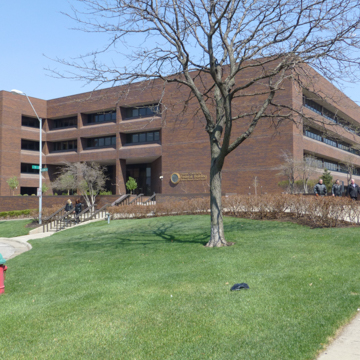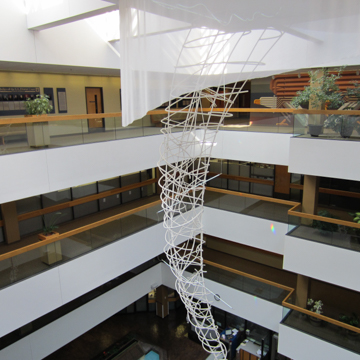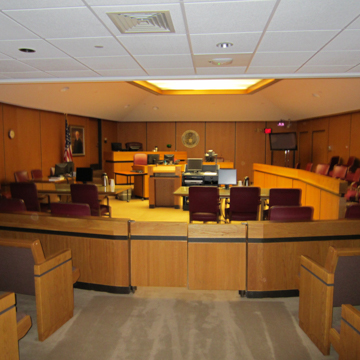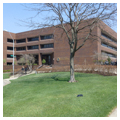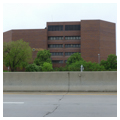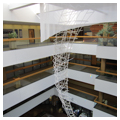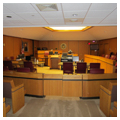The Carlson Federal Building exemplifies office architecture of the post–1973 oil embargo era. It pioneered a variety of energy-saving ideas and also exhibited careful planning that maximized tenant flexibility. The building gained unexpected significance in 1993 when it became the first federal facility to experience a terrorist attack, ultimately changing the nature and design of governmental spaces.
Curiously sited on the southeastern corner of Topeka’s downtown, the rear of the Carlson building is visible from I-70 as it winds its way around the central business district, but it is not easily accessible from this or other major streets. The front of the building faces the back of the now abandoned post office, and is accessible only from a small, one-way loop street that passes around it.
The Carlson Building was designed by a geographically representative group of architects who called themselves Kansas Architects and Planners Associated. The firm consisted of Eicholtz and Groth of Topeka, Kivett and Myers of Kansas City, Peters Williams and Kubota of Lawrence, and Woods and Starr of Hays. The building has six levels. The lower two are accessible from the rear, and consist of a parking garage that encircles a small suite of offices. The third level is the pedestrian entry level and houses a generous atrium, cafeteria, and office space. The fourth and fifth floors accommodate offices for a variety of federal agencies. The top floor contains courtrooms and offices of the District Court.
The office spaces on the third through fifth floors are available for lease to a changing array of governmental agencies. They have housed a variety of uses from armed services recruiting stations to senators’ offices. The building’s interior features were designed to facilitate the flexibility of these spaces. For example, the spaces include raised access flooring for easy maintenance of electrical and telecommunication lines and flexible air distribution systems. The offices also feature demountable modular partitions that hook into mounting tracks on the floors and ceilings, thereby facilitating the reorganization of the spaces. Unfortunately, the module for the demountable items has changed over time and replacement parts are no longer available, rendering the spaces less flexible than anticipated.
At the time of its construction, the Carlson Building was the most energy-efficient federal building in the nation. The deep-set windows serve as a natural shading device. A state-of-the-art energy management system calculates the heat generated by human occupancy, and allows the all-electric heating to be delivered exclusively by resistance coils located beneath exterior windows. The most striking feature of the building’s interior is a gracious four-story, sky-lit atrium. It provides natural day-lighting at the center of the building, thereby reducing the amount of electric lighting that needs to be supplied to surrounding spaces.
The Carlson Building’s deep-set windows give it a sense of mass and substance. This impression is reinforced by its dark brick facade and bold geometry. The design kept with the evolving aesthetic of the time, which began to favor a heavier and more massive expression. While not terribly welcoming, the building’s fortress-like appearance provides the sense of permanence and stability appropriate to a governmental structure.
On August 5, 1993, sixteen years after the building opened, the Carlson Federal Building became the site of the nation’s first major terrorist attack. Early that morning, an armed gunman parked his car in a visitor’s parking space adjacent to the parking garage. The attacker then entered the building through an unattended garage entry ramp. Once in the building, he detonated a bomb in his car, and proceeded to the sixth floor where he shot six people before taking his own life. This attack forever changed the design of governmental buildings, and the changes implemented to the Carlson Building in the wake of the tragedy provided an example that was to be followed in retrofitting other buildings around the country. Twenty-three entrances were reduced to only two guarded pedestrian entries and one secured garage entry. While many changes were minor, others were more invasive, such as cutting through a garage floor to put in a driving ramp to connect the parking levels. Some alterations compromised the building’s energy-saving features. For example, many of the transparent walls around the atrium were replaced with opaque bomb-proof barriers, transforming it from a grand and popular public space into little more than a large well-guarded foyer.
References
Scherr, Allen, facility manager. Interview by David Sachs. Topeka, KS, April 24, 2014.

